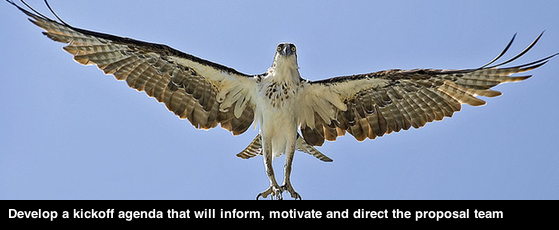In the last three posts we covered proposal kick-off goals, preparation and participants. Now let’s look at a recommended structure and tips for running the meeting.
The agenda below will fit most proposals. For very large proposals, volume managers and senior editors may attend kick-offs, and then kick off individual volumes with their teams of writers, editors, graphics specialists and designers.
TIME (min.) | PRESENTER | RESPONSIBILITIES |
| 5 | Proposal Manager | Welcomes and introduces participants, reviews agenda |
| 5 | Senior Manager* | Explains the importance of the project and the organization’s commitment, thanks the team members for their participation |
| 10 | Sales Manager* | Provides background on the prospect and project, including any competitive intelligence indicating the bid is winnable |
| 10 | Product Manager* | Describes the proposed solution, its main features and successful deployments elsewhere |
| 15 | Proposal Manager | Outlines the proposal structure, prospects strategic drivers and key issues, and win themes; distributes writers’ packages, key dates |
| 15 | BREAK | |
| 30 | Proposal Manager | Reviews in detail the proposal plan, ATOC, work organization and allocation, writer’s packages (SCPs) and executive summary |
| 10 | Project Manager** | Reviews the schedule, online storage set-up, versioning protocols and daily management procedure |
| 20 | Proposal Manager | Invites questions from writers/editors, subject matter experts, graphics specialists and designers |
*These individuals and any non-presenting managers may leave at the break ** If there isn’t a separate project manager, the proposal manager presents this session | ||
Aim for in-person attendance
Get as many people to attend in person as possible. Kick-offs have less energy and impact when most attendees dial in. Also, we find some individuals feel less obliged to meet commitments made on a conference call.
Set the right pace and tone
Plan a professional meeting that moves briskly through the agenda items. Aim to balance achieving motivation, information and clear direction. Schedule the meeting to run no more than two hours.
Here’s where the effort you put into strategy making will pay off. Content developers—your main audience—are sceptics by nature. Part of their value lies in knowing that facts beat fluff. They’ll be looking for the meat in the meeting. Your prework and a strong agenda above will ensure you deliver.


